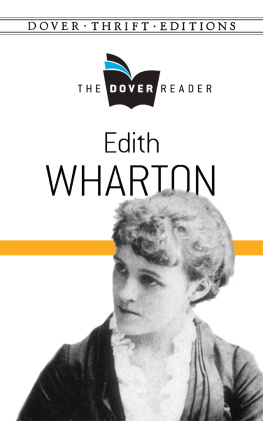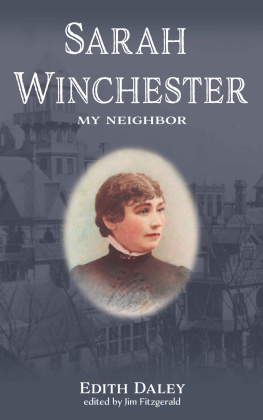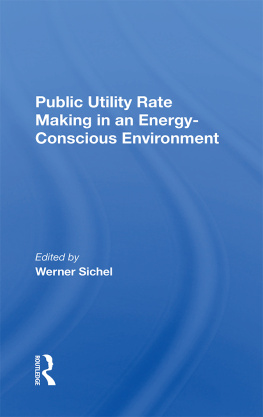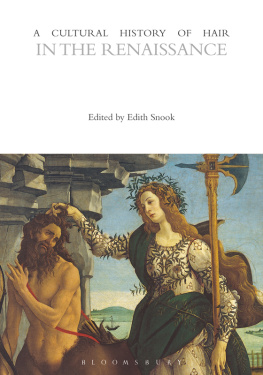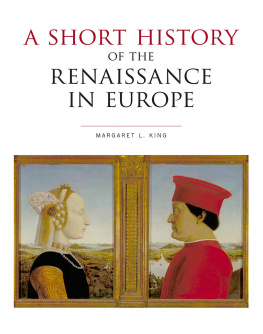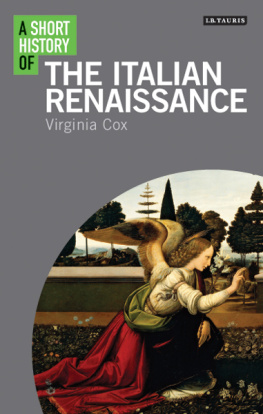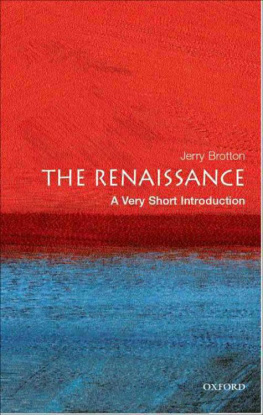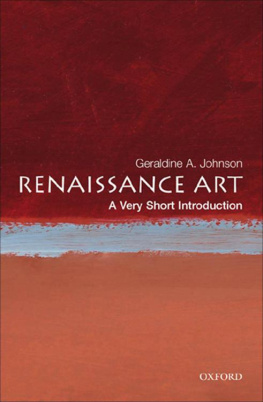INTRODUCTORY
MICHAEL ANGELOS GREAT PAINTING OF the newly created Adam on the ceiling of the Sistine Chapel might be taken as a symbol of the Renaissance, of the time when man was, as it were, re-created more glorious than before, with a body naked and unashamed, and a strong arm, unimpaired by fasting, outstretched towards life and light. Definitions are generally misleading, and it is easier to represent the Renaissance by a symbol than to define it. It was a movement, a revival of mans powers, a reawakening of the consciousness of himself and of the universe a movement which spread over Western Europe, and may be said to have lasted over two centuries. It was between 1400 and 1600 that it held full sway. Like other movements it had forerunners, but, unlike other movements, it was circumscribed by no particular aim, and the fertilizing wave which passed over Italy, Germany, France, England and, in a much fainter degree, over Spain, to leave a fresh world behind it, seems more like a phenomenon of nature than a current of history rather an atmosphere surrounding men than a distinct course before them. The new birth was the result of a universal impulse, and that impulse was preceded by something like a revelation, a revelation of intellect and of the possibilities in man. And like the Christian revelation in the spiritual world, so the Renaissance in the natural, meant a temper of mind, a fresh vision, a source of thoughts and works, rather than shaped results. When it crystallized into an sthetic ritual, it fell into decadence and corruption.
But before that happened, its real task had been accomplished a complex task, in which certain elements stand out. Two main things there were which the Renaissance of Western Europe signified: it signified Emancipation and Expression. The Renaissance is a loose term which has served to cover many issues the Revival of Learning, the regeneration of art, the revolt against the Schoolmen, the expansion of mens thought with the expansion of the world beyond the seas. And it has been ascribed to many external causes greater and less. The death of feudalism had given free play to the individual and had weakened authority. The famous taking of Constantinople by the Turks in 1453, which put an end to the Greek Empire, had sent Greek scholars wandering over the world and shipped west into Italy a glorious cargo of looted manuscripts and sculptures. The discovery of printing, with the consequent circulation of books and of thought, produced a change that was immeasurable; while the discovery of America and the obvious effect that it produced upon trade profoundly modified the laws of wealth and the possibilities of transit. But all these outward events were only visible signs of a great motive power that grew from within; of the reassertion of Nature, and of her rights, against asceticism; of the disinterested desire for knowledge for its own sake not the Schoolmans desire for logical results, or that of the alchemist who regarded science as a A 2 means to find the philosophers stone, but for something far wider. Rabelais giant baby, Prince Gargantua, born in the open air, in the midst of a festival, waking to life parched with thirst and calling loudly for drink, must have been a conscious symbol of the child of the Renaissance, who came forth into the world unswaddled, and athirst, to drink deep and grow strong enough for the overturning of false barriers, and the reinstatement of those senses which religion had taught him to contemn. Beauty was manifested to man afresh beauty and joy which he had learnt to regard as the deadly foes of Christianity. And, inspired by new- found marbles and manuscripts, in a kind of intoxication, he once more embraced Paganism and Nature, and acknowledged mans body to be the exponent, not the adversary, of his soul.
Here there comes in the second great element of the Renaissance Expression. Expression implies a consciousness of that which is expressed. In the Middle Ages expression in words or stone or painting was naf, a matter of narrative and of symbols, prescribed mostly by tradition. If personal force pierced through, it was accidental when men of exceptional gifts happened to be employed. But as people became more conscious of themselves and the world, and began to want to define their relations towards it, and when they finally reawakened to a sense of beauty, emotion was kindled and expression sought and found. There arose, first in Italy, then in other lands, a perfect passion for language. The fuel was ready, the re-discovery of the classics set it alight. The unearthing of manuscripts in remote and forgotten monasteries, the publication of the works of Virgil and Seneca, Plato and Aristotle, with a score of other ancient authors, acted upon mens imaginations. Scholarship in those days was no set science; it involved risk, it unfolded unknown vistas. Like all else, like science itself, it was bathed in an atmosphere of poetry. Men approached new-found manuscripts with excitement and reverence.
When Poggio Bracciolini (1380-1459) discovered an ungarbled text of Quintilian Institutions, there was an almost religious exaltation; while the great Lorenzo Valla (1406-1457) urged the claims of Latin with the zeal of a propagandist. Scholars and students unknown to one another corresponded all the world over, formed friendships, compared texts, communicated fresh niceties of erudition. The Scaligers in Verona, the Estiennes in France, the preeminent Erasmus of the Netherlands, the rest of that wonderful band of men who tried to apply learning to life and went by the name of Humanists, revealed and increased a hundredfold the powers and possibilities of language. And in doing so they performed a work more important for the nations than scholarship. They increased vocabulary, and with it the national mind. Few words mean few ideas, and vocabulary is a fairly safe index of a countrys intellectual outlook. Literature is, foremost, a sweetening and civilizing influence. But, unconsciously, it has a further power, not deeper, but more far-reaching the faculty to propagate words and widen the horizon. This is what happened in the early Renaissance; presently scholarship ceased to be emotional, it became prosaic, and then it grew formal. Words fresh from the mint were over-used and, turning against themselves, finally hardened into shibboleths or eupheuisms. Humanists gave place to pedants. But the words introduced by scholars quickly filtered into common speech; the vulgar tongue was enriched; and the spirit of research went outside the classics, revising old folk-songs, forming schools of popular poets. The Stornelli and Rispetti (songs of the country-side, many of which are still existent), the Ballate (dance-songs), the sacred songs, or Laude, and such-like traditional verse, served as a ready means for the ripening of the Italian mother-tongue and the rehabilitation of homely themes. And in France Fables, and Romances of chivalry did much in the same fashion to keep the French language alive. The exclusive employment of Latin in the world of letters had been the link between the Middle Ages and the Renaissance. The growth of national speech and its gradual encroachment upon Latin as a literary medium was the link with modern times. In later days this growth, by these means, formed such natural poets in Italy as Lorenzo de Medici, Poliziano, and Pulci, or as Villon and Marot in France. Literature became what it was meant to be, the property of the people. Language, however, is but one part of expression, and art was, perhaps, the most potent and enduring means of self-revelation chosen by the Renaissance. In painting, in sculpture, in chiselled gems and goldsmiths work, that wonderful period flowered and seeded, as fertile as if it were a second Nature with its own laws and seasons, until expression degenerated into over-expression and art grew decadent and died of surfeit.



